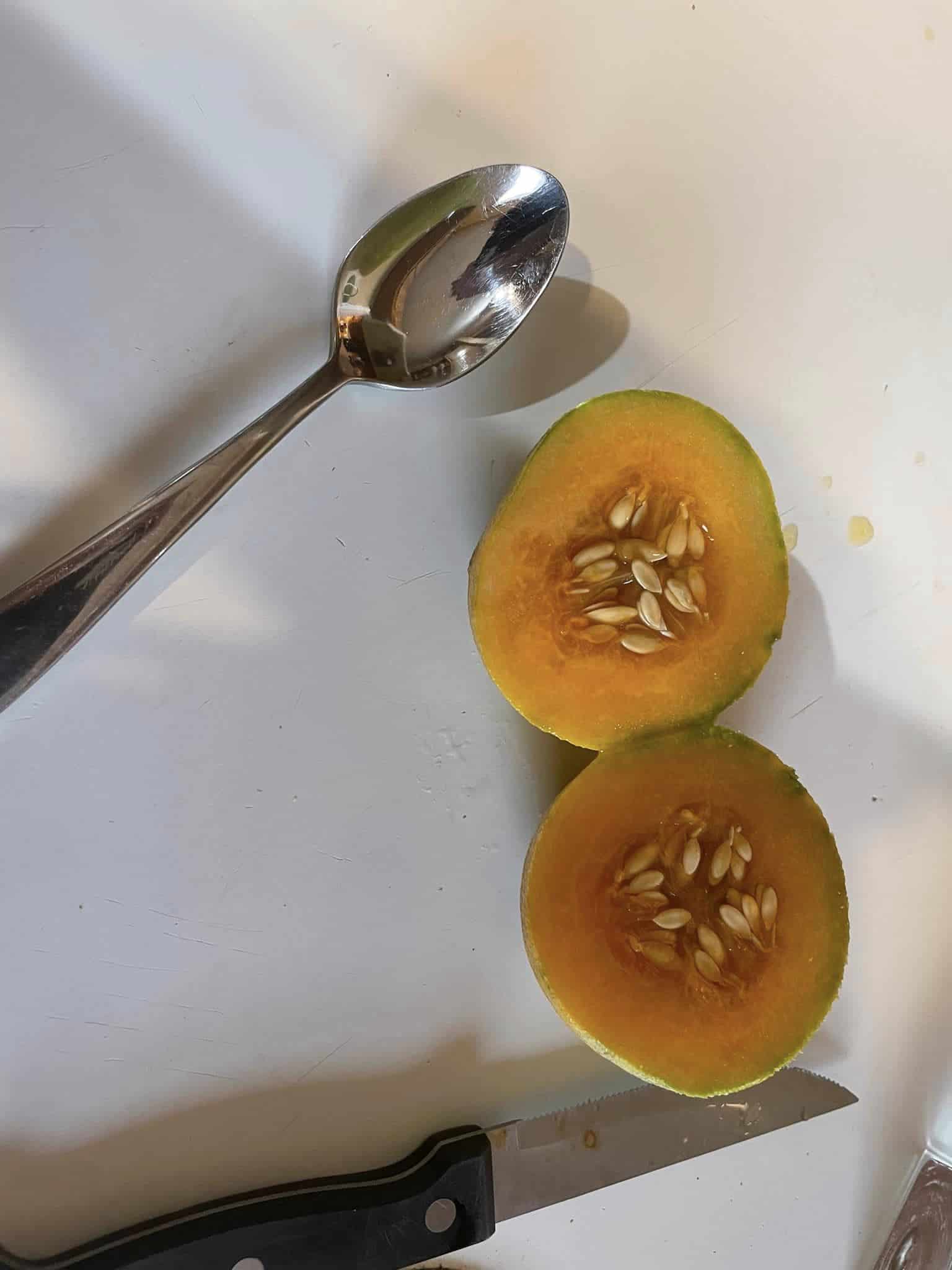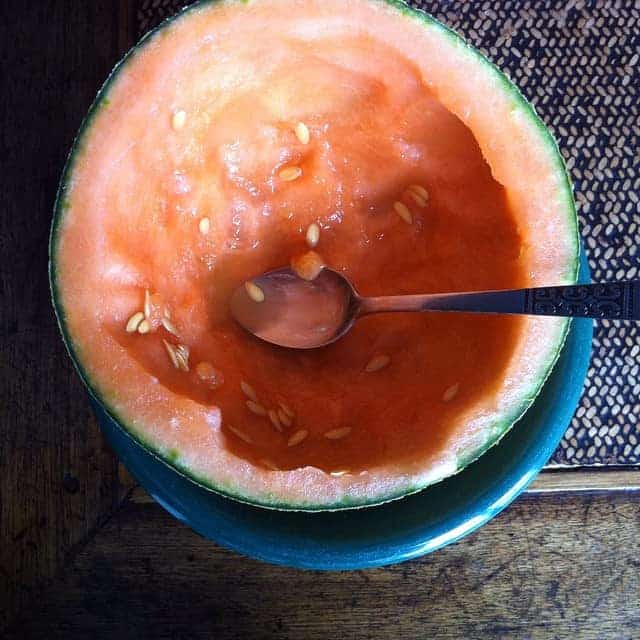Last year I visited California to help my uncle pick Cantaloupe (Cucumis melo var. cantalupensis) fruits and pack them for the market.
After learning about the gross harvest of Cantaloupe and its income, I could not blink my eyes. And with that motivation, I added new crops to my farm and built my long-desired farmstead with only Cantaloupe.
If you are eager to plant and leverage the Cantaloupe fruits, start collecting Cantaloupe seeds instantly.

This may get you a skimming guide that can overrule you in your farming journey.
Let me tell you what I did so you can do the same and get viable seeds to plant Cantaloupe next year.
Table of Contents Show
What Do Cantaloupe Seeds Look Like?
Cantaloupe is an annual summer plant that grows naturally in zones 4-10.
The vine can grow 15-18 inches in height and 72 inches in spread. A single Cantaloupe plant can produce four to eight delicious melons, with each fruit weighing 0.5 to 5 kilograms.
That said, Cantaloupe can also contain plenty of seeds in the juicy fruits. Let us look at the basic overview of Cantaloupe seeds.
| Seed Attributes | Features |
|---|---|
| Color | Creamy White |
| Shape | Oval, Elliptical |
| Size | About 1 cm |
| Harvest Time | Summer |
| Weight | About 30 milligrams |
| Sowing Method | 0.5 inch holes, 20-24 inches apart |
| Germination Initiator | Temperature |
| Seed Sowing Time | 3 to 4 weeks before the last frost date |
| Germination Time | 5-7 days |
| Number of Seeds Per Ounce | 1000 |
| Toxicity | Non-toxic to humans and pets |
| Uses | Antioxidant, Helps with weight loss, Promotes hair and nail growth, Propagation |
Now you know what Cantaloupe seeds look like; you can buy one from the store, extract its seeds, and plant it immediately.
Or even better, you can store the seeds for better use.
How to Harvest Cantaloupe Seeds?
To harvest the Cantaloupe seeds, you need the fruit to mature entirely first. The process from germination to maturity takes about 65-90 days.
If the fruit’s stem end gives off a pungent melon smell, you can conclude that the seeds are ready. You must wait for the melon to become ripe and detach itself off the stem to get the seeds.
To harvest the Cantaloupe seeds, you will need the following equipment.
| Materials | Purpose |
|---|---|
| Isopropyl Alcohol | To sterilize the gardening equipment |
| Safety Goggles | For extra protection |
| Gardening Gloves | To protect the hands |
| Kitchen Knife | To cut the fruit open |
| Glass Jar | To keep the seeds |
After successfully collecting the equipment, you can move on to the harvesting process.
- Sterilize the equipment with isopropyl alcohol before harvesting the seeds.
- Take the kitchen knife and make a linear cut on the Cantaloupe fruit.
- Separate the two halves of the fruit to reveal the seeds.
- Gently scrape out the seeds and remove the surrounding membrane.
- Place the seeds over a paper towel or plate and let them dry.
You can also check the viability of the seeds by placing them in a transparent jar filled with warm water. Let the seeds stay there for about 3-4 days.
Cantaloupe seeds that sink in the water are viable and ready to be planted, whereas those that float on the top are not good.
Once you check the seeds, discard the water with bad seeds and keep the good seeds for future use.
How to Save and Store Cantaloupe Seeds?
After successfully extracting the seeds, you must prepare to store them and plant them when needed.
Follow the steps to keep the seeds viable for planting in the future.
- You must know that you must keep the seeds on a paper plate to let them dry completely.
- Stir the seeds, and do not let those seeds stick to the paper plate. Repeat the process every day.
- The seeds may take about 5 to 7 days to dry out completely.

- Place the Cantaloupe seeds in a plastic bag, or keep them in a plastic bag if they have completely dried.
- Store the extracted Cantaloupe seeds in an airtight container in a dark, cool, and dry location. Many people prefer to store the seeds in the refrigerator or their basement.
If the seeds come in contact with moisture and humidity, they will go bad, and so will your dreams of planting them next year.
Remember to let the Cantaloupe seeds dry completely before storing them. If they do not dry properly, mold can grow on the seeds.
I suggest you label the envelope properly with its harvest date to know your seeds at the time of planting.
What to Do with Cantaloupe Seeds?
Cantaloupe seeds don’t only contribute to the continuation of the plant’s generation but also provide a lot of medical benefits.
On top of that, you can eat them too. Cook them, roast them, or eat them raw; they provide many options.
Let us look at the benefits the mere seeds provide.
- According to IJCRT, Cantaloupe seeds comprise 17.64% protein, 35.48% dietary fiber, 9.7% carbohydrates, and 425.41 Kcal calories.
- These seeds can also help to keep your blood pressure in check thanks to their 25.48 ± 1.44 mg GAE/e of polyphenol content.

- It has antioxidant, anti-inflammatory, antiulcer, antidiabetic, and antibacterial properties.
- The seeds of Cantaloupe have omega-3 fatty acids, which are great for cardiovascular health.
- As Cantaloupe seed is an excellent source of fiber, its consumption can also help achieve that unachievable weight loss.
- You can roast and sprinkle the seeds over your food and fruits to enhance the taste.
- Melon and Cantaloupe seeds can also increase your bone strength.
If you have not grown the Cantaloupe plant, you can easily buy fruit online or order the seeds.
Editor’s Note
The journey from harvesting to saving Cantaloupe seeds is swift and easy. When saving the Cantaloupe seeds properly, they can be viable for four years.
Once you have seeds, you can plant them two weeks after the last frost date.
Have a good day!


